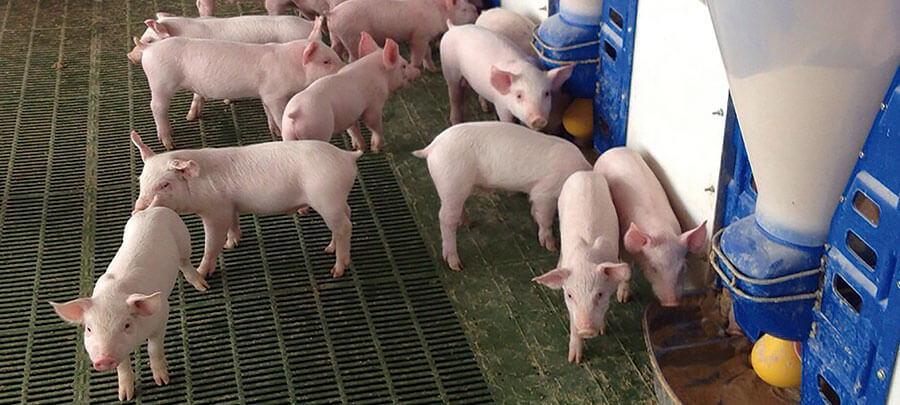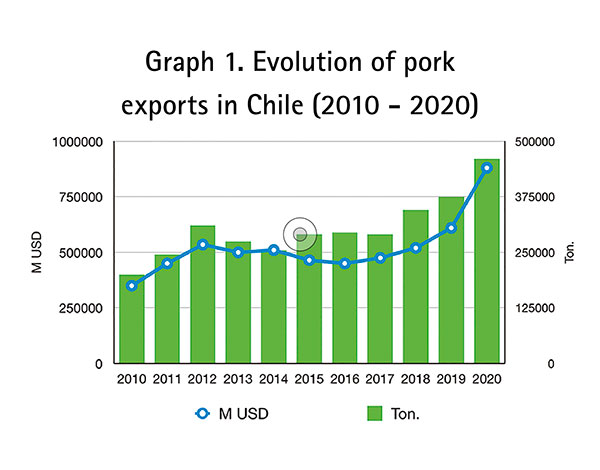Blog
Blog

Chile increases its pork exports
16 of December of 21 - News
In recent years, pork exports have become the growth engine of the Chilean pork industry, which exports 81% of its production to more than 60 countries worldwide. This evolution has been possible thanks to the different players in the sector, which has turned Chilean pork into an efficient industry capable of adapting to the challenges that health and environmental demands have posed over the years.
Production
Currently, the pork industry is the second most essential meat production in Chile, behind poultry. In 2020, pork accounted for 36% of the total meat produced in Chile, with 574,000 tons. One of the keys to this number lies in the great effort of the pork industry to be more efficient in all its processes. Pork production in Chile is characterised by being enormously intensive, with high levels of technology, vertically integrated into the different links of the chain and concentrated in a few players. Thanks to this technification, Chile can export more than 80% of its total pork production.
Exports
The Chilean pork industry can export to more than 60 markets worldwide, so exports are the growth engine of the pork industry in the country. After more than 25 years of work, Chile occupies the sixth position in the ranking of pork exporting countries in volume and the thirteenth position in value. Thus, the export growth of the pork industry has been increasing, going from exporting 3,500 tons in 2000 to more than 450,000 tons in 2020 (Graph 1).

In the past year, exports increased by 25% in tonnes and 39% in value compared to 2019. The main destinations for Chilean pork were China (67%), which maintains first place, followed by Japan (14%) and South Korea (13%). Thus, the Asian market accounted for 94% of total exports in the last year. In tons, China has remained the primary destination market, reaching 336,000 tons.
The secret of this export potential is, possibly, in strict compliance with all sanitary requirements, both in Chile and in the export destination markets. However, to continue growing in this aspect, a precise territorial planning regulation is necessary to increase the exportable supply and thus maintain Chile’s position in foreign markets.
Imports
As for pork imports, in the last year, they showed an increase of 5%, going from importing 151,000 tons in 2019 to 159,000 tons in 2020. This upward trend, which has been taking place year after year for a decade, is explained by growing national demand. On the other hand, the leading countries of origin of imports were the United States (47%), Brazil (37%), the EU (8%) and Canada (4%).
Consumption
During the last year in Chile, Pork consumption reached 268,000 tons, representing 19% of total meat consumption, with a per capita figure of 13.8 kg per person per year. In this way, pork is the third most consumed meat in Chilean households.
Initiatives to promote sustainability
The pork industry in Chile has developed different projects to advance in terms of the industry’s sustainability. In 1999, the first Clean Production Agreement (APL) was signed, which addressed waste management or odours issues. Years later, in 2005, the pork industry signed the second APL, which on this occasion included different objectives on occupational hygiene and safety, slurry management, odour management, etc. Thanks to these sectoral initiatives, Chilean pigs have made progress in multiple aspects of sustainability and, above all, environmental performance.
On the other hand, for almost 20 years, the Association of Pig Farmers of Chile (ASPROCER) has carried out different projects to improve the sector: the Swine SME Project (2017-2019) to promote the use of technologies for the treatment of slurry in small and medium enterprises; the Community Relations Project (2015), to know and understand the social reality of the communities that live in the area of direct influence of the farms of pigs, and the Public Good for Competitiveness Project (2019), which sought to improve sustainability and enhance the global recognition of Chilean food products and companies, through the development of certifiable sustainability standards. On the other hand, ASPROCER has been working on animal welfare issues since 2004 and has set up a committee that has developed a manual of good practices.
Future
With all the above, the pork industry in Chile presents excellent commercial opportunities, even more so if we consider the projections of the demand for pork at a global level. However, to take advantage of them, it is necessary to face the challenge of developing an increasingly sustainable production, meeting the levels of quality and flavour required by the markets. As we have seen, in recent years, the Chilean pork industry has successfully implemented different initiatives to advance in this regard, allowing the country’s pig to continue on the path of efficiency and sustainability.






